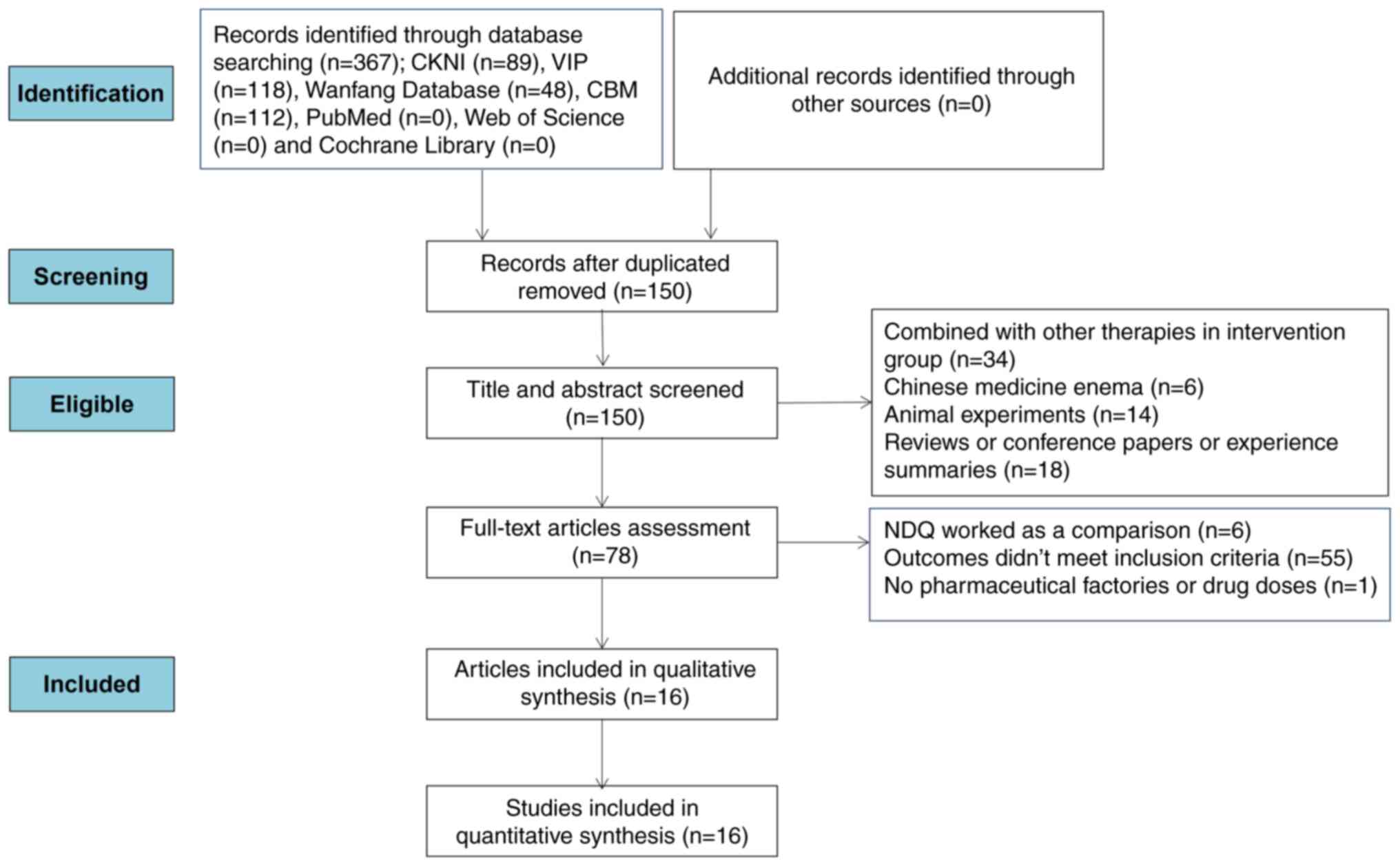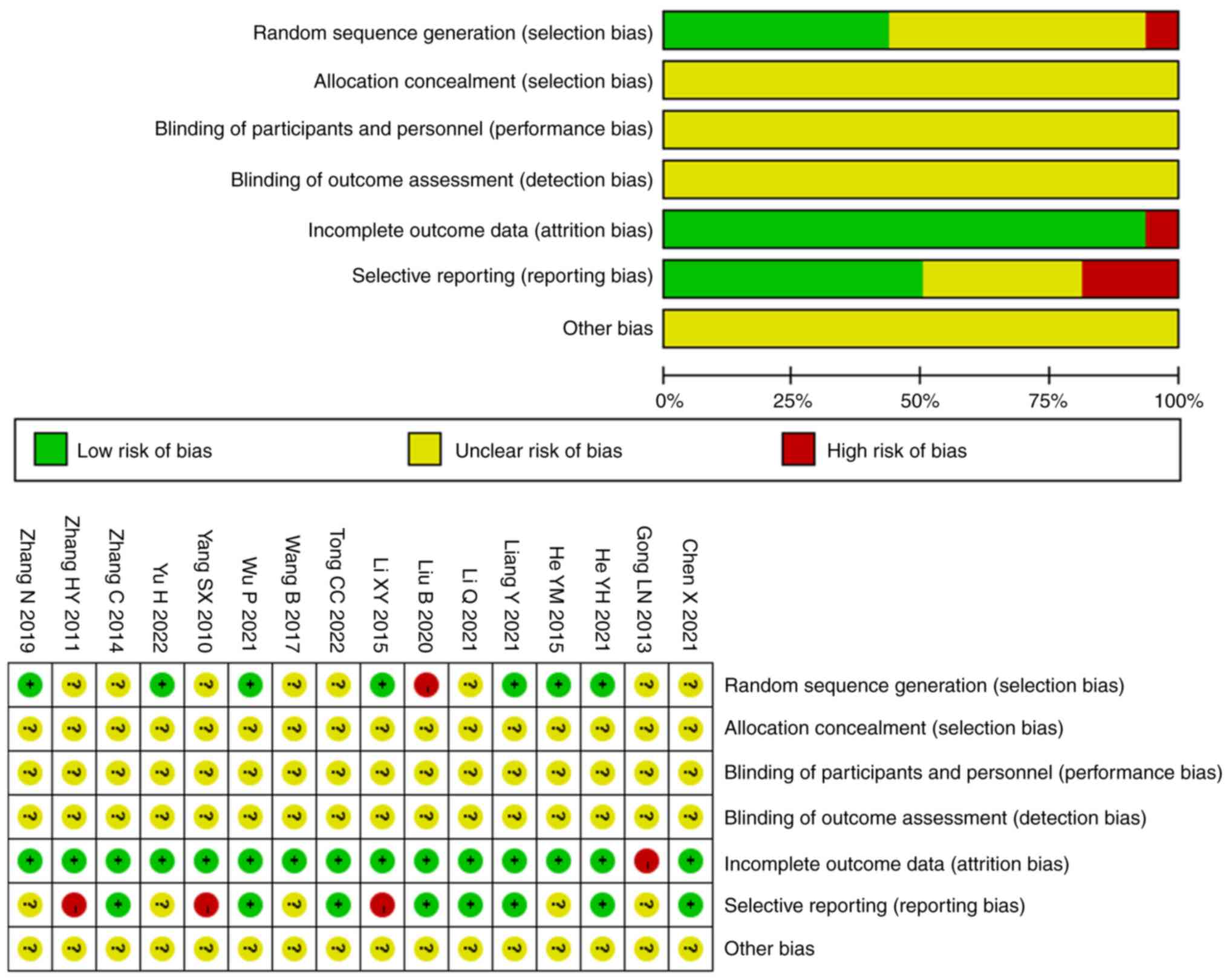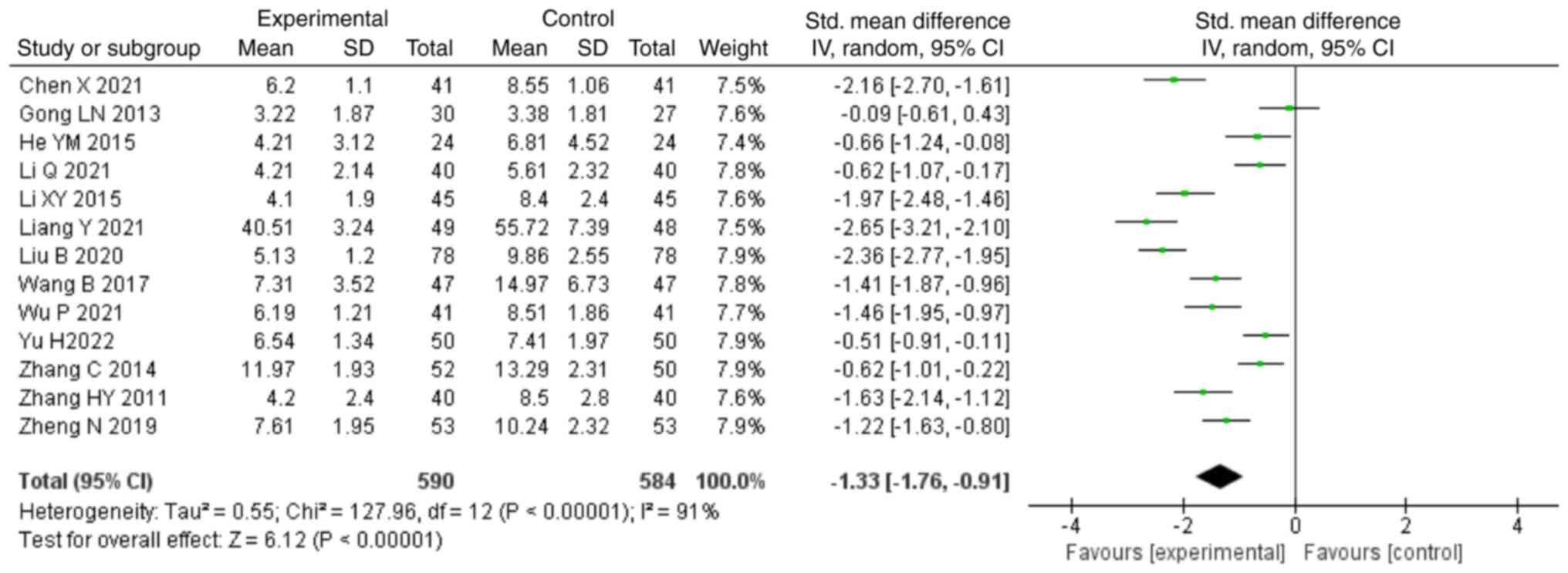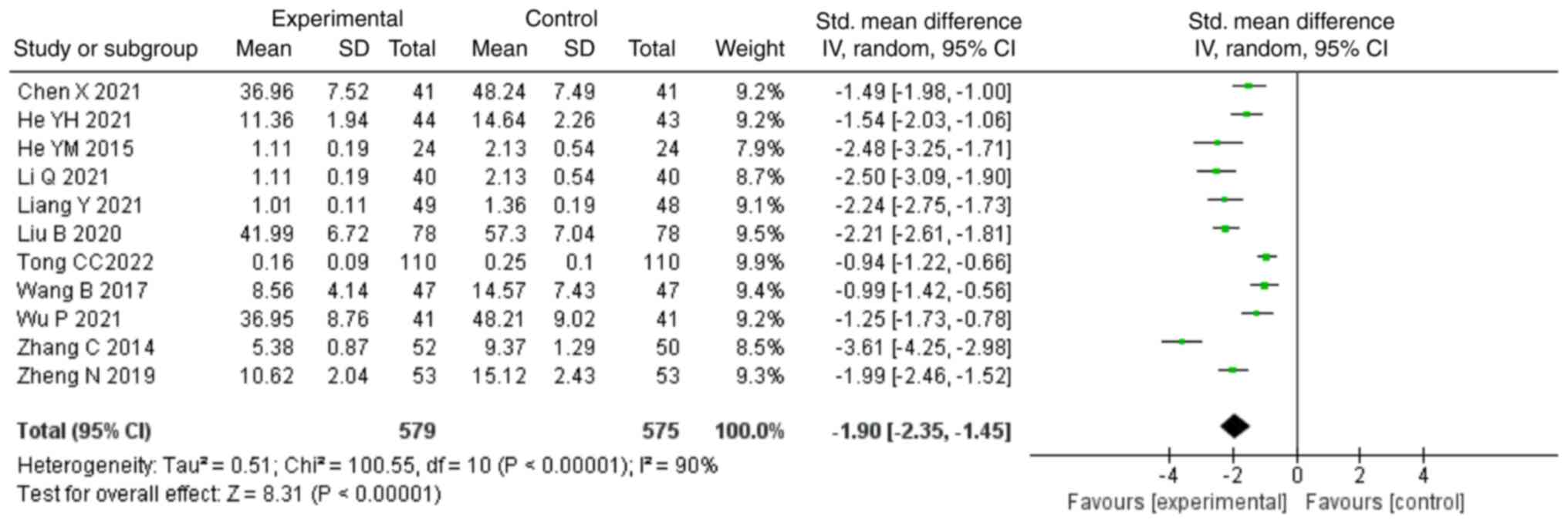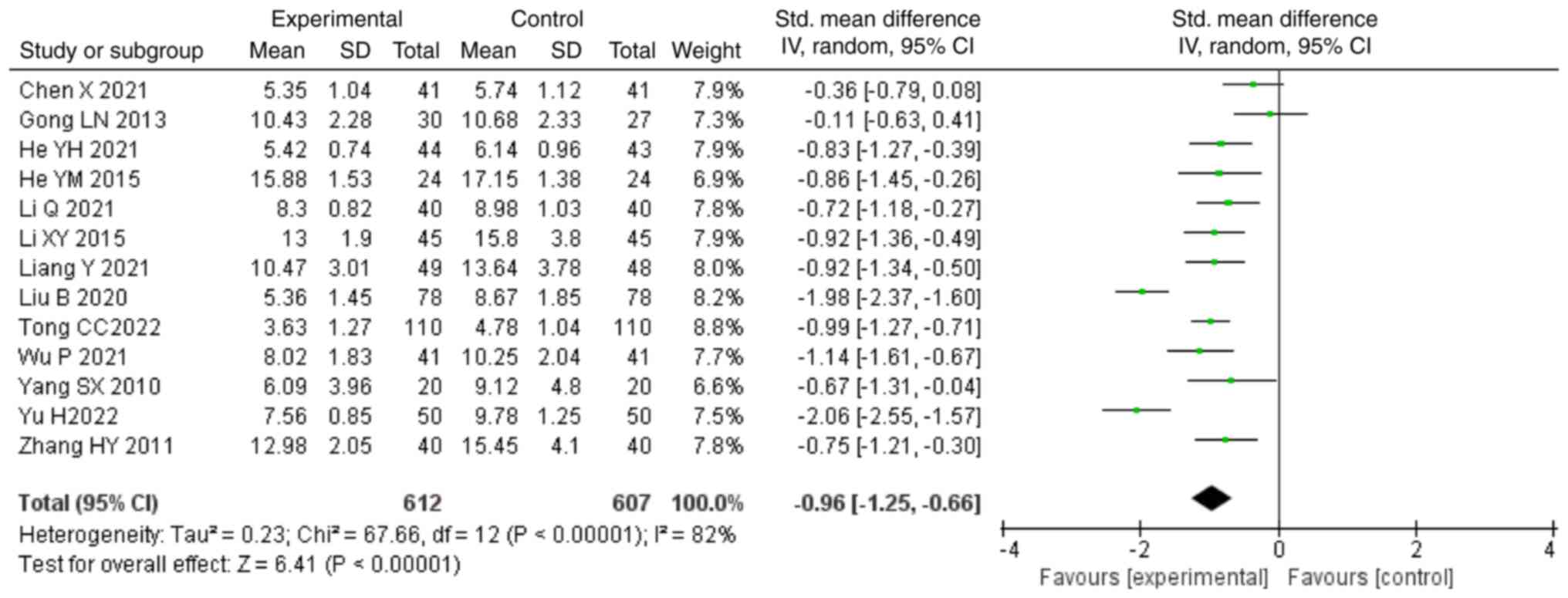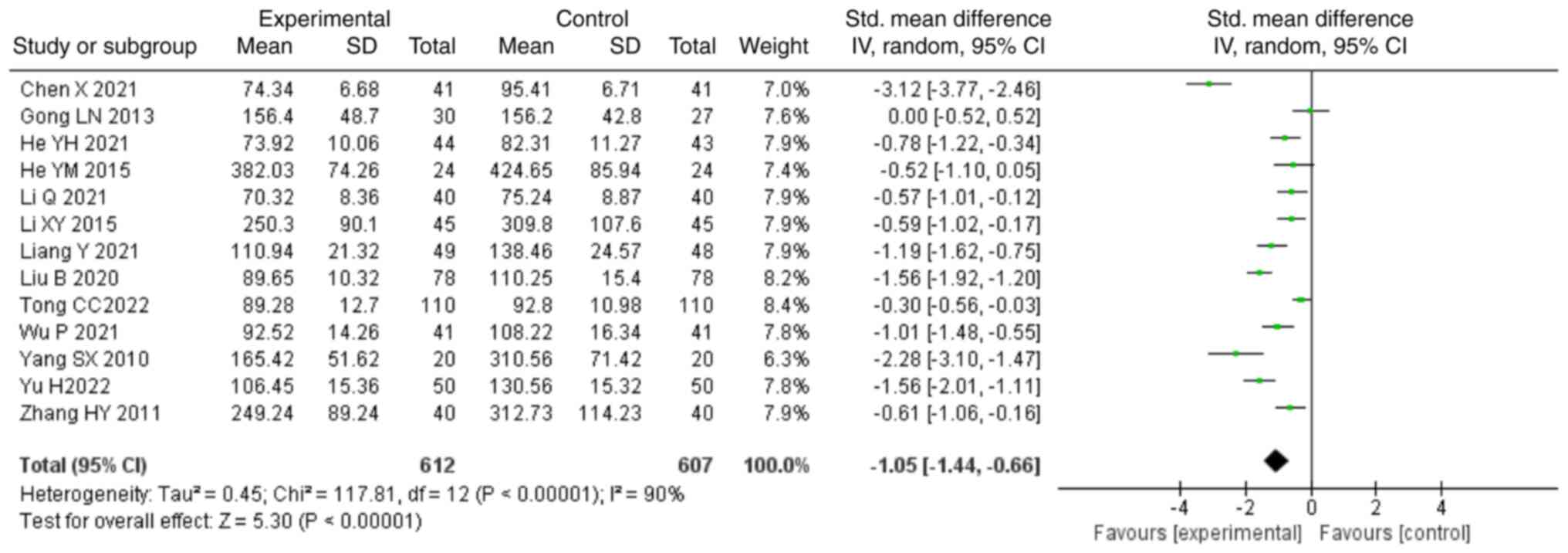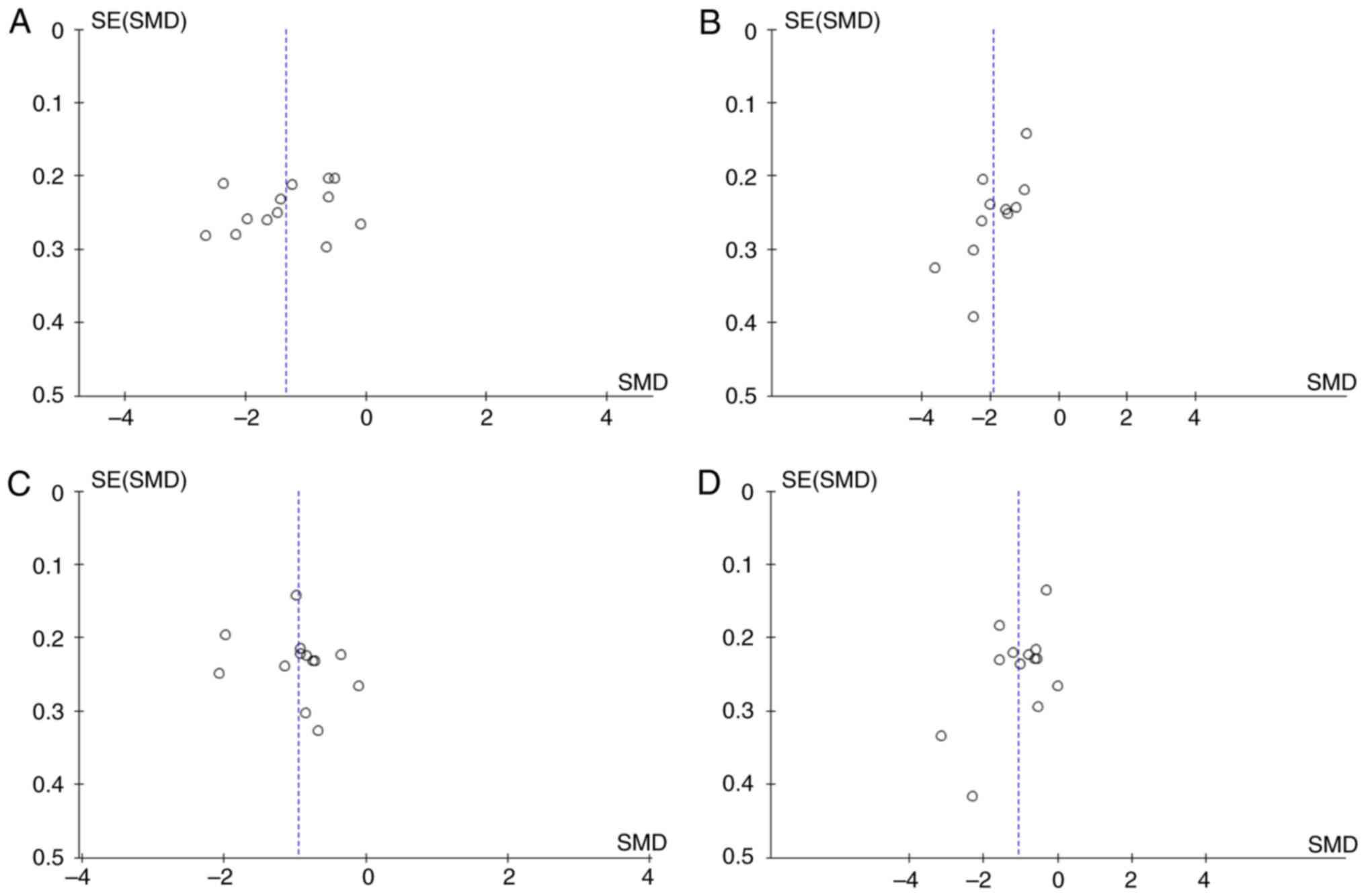Effects of Niaoduqing granules on inflammatory response of diabetic kidney disease: A meta‑analysis
- Authors:
- Published online on: September 6, 2023 https://doi.org/10.3892/etm.2023.12193
- Article Number: 494
-
Copyright: © Zhou et al. This is an open access article distributed under the terms of Creative Commons Attribution License.
Abstract
Introduction
Diabetic kidney disease (DKD) is one of the most severe chronic complications in patients with diabetes mellitus (DM) and the leading cause of end-stage kidney disease (ESRD) worldwide (1,2). Consequently, DKD-associated ESRD incurs colossal human, social and financial burdens. In 2019, it was estimated that ~463 million individuals were afflicted with DM according to the statement of International Diabetes Federation, the number of which is predicted to increase to 693 million in the next 25 years (3). According to the latest epidemiological survey in China, 34.2% of patients with DM developed DKD (4). Therefore, the early diagnosis and treatment of DKD are of high importance. Since the pathophysiology of progressive microvascular decay caused by DM and its association with inflammatory response was first proposed in 1999(5), accumulating evidence has supported the notion that the inflammatory response serves a vital role in the occurrence and progression of DKD (6). Such reported inflammatory factors include C-reactive protein (CRP), TNF-α and IL-6. A randomized, double-blind, placebo-controlled 3x3 crossover study previously demonstrated that angiotensin-converting enzyme inhibitors and angiotensin receptor blockers (ARB) were able to induce anti-inflammatory effects (7). In addition, sodium-glucose co-transporter 2 (SGLT2) inhibitors were shown to provide renal protection other than decreasing glucose and reducing the events of composite cardio/kidney endpoints (8). However, SGLT2 inhibitors may also decrease the estimated glomerular filtration rate (eGFR) and increase the risk of genitourinary system infection and ketoacidosis (9). A systematic analysis of a series of chronic kidney disease (CKD) cases from 1990 to 2017 published in The Lancet concluded that the currently existing treatments are not sufficient to prevent the deterioration from CKD into ESRD (10). Therefore, there are substantial challenges remaining in treating DKD, such that more effective novel treatment methods are urgently in demand.
Emerging advantages of Traditional Chinese Medicine (TCM) have been garnering attention in both academic and clinical research fields. DKD pertains to the category of ‘Shenxiao’ in TCM (11). On the basis of the theory of TCM, deficiency of kidney and spleen along with dampness, turbid phlegm and blood stasis dominate the pathogenesis of DKD. Correspondingly, the treatment principle is to tonify kidney and spleen, replenish water and tonify qi, supplemented by activation of blood and dissolution of stasis. Niaoduqing (NDQ) granules is a patented TCM formulation that has the reported functions of ‘tonifying spleen’ (jian-pi), ‘free fu’ (tong-fu) and ‘eliminating pathogens’ (jie-du). It has been applied in clinical practice in China for ≥20 years. The NDQ granules received approval by the China State Food and Drug Administration (National Medical Products Administration) to treat CKD (national medicine permit no. Z20073356) in 2000. It is composed of 16 TCM herbs (12), including rhubarb root and rhizome (Radix et Rhizoma rhei), white paeony root (Paeoniae Radix Alba), milkvetch root (Astragali Radix), Pinellia ternata (Pinelliae Rhizoma), chrysanthemum flower (Flos Chrysanthemi), Danshen root (Radix Salviae miltiorrhizae et Rhizoma), Szechuan lovage rhizome (Chuanxiong Rhizoma), tuber fleeceflower root (Polygoni Multiflori Radix), Medicinal Changium root (Changii Radix), Largehead Atractylodes Rh (Atractylodis macrocephalae rhizoma), Indian buead (Poria), white mulberry root bark (Mori Cortex), lightyellow sophora root (Radix Sophorae Flavescentis), Asiatic plantain herb (Plantaginis Herba), Chinese Thorowax root (Bupleuri Radix) and liquorice root (Glycyrrhizae Radix et Rhizoma). NDQ granules have been used to treat patients with CKD according to the ‘Clinical Application Guide of Chinese Patent Medicine in The Treatment of CKD’ (13). Over the past few years, various clinical trials have attempted to assess the effects of treatment with NDQ granules on DKD, and its effectiveness has been initially verified. Evidence from these clinical studies suggested that the NDQ granules are not only able to improve kidney function, but may also reduce the severity of the inflammatory response by adjusting the micro-inflammatory state compared with basic treatment or placebo (14,15). However, the sample size of available clinical trial data on NDQ granules in terms of its anti-inflammatory effects is relatively small, rendering the evidence inconclusive. Therefore, the present systematic review and meta-analysis was performed to assess the effects of NDQ granules on the inflammatory response to provide additional information on the effects of TCM treatment on DKD.
Materials and methods
Database and search strategies
The present systematic review and meta-analysis was performed in accordance with the Preferred Reporting Items for Systematic Reviews and Meta-analyses statement (16), and has been registered to PROSPERO (https://www.crd.york.ac.uk/PROSPERO/; registration no. CRD42022340017). However, it should be noted that the final search date was extended to 31st of May 2023 to include the most up-to-date clinical studies. In total, seven electronic databases, namely the China National Knowledge Infrastructure database (https://www.cnki.net), China Science and Technology Journal Database (www.cqvip.com), Wanfang Database (https://www.wanfangdata.com.cn), the Chinese Biomedicine Database (http://www.sinomed.ac.cn/), PubMed (https://pubmed.ncbi.nlm.nih.gov), Web of Science (www.webofscience.com) and Cochrane Library (https://www.cochranelibrary.com) were searched comprehensively for literature from their inception to 31st of May 2023. Only papers published in Chinese and English were selected. The search terms used were as follows: ‘NDQ’, ‘NDQ granules’, ‘NDQ particle’, ‘uremic clearance granules’, ‘diabetic kidney disease’, ‘diabetic nephropathy’, ‘nephropathy, diabetic’, ‘kidney disease, diabetic’, ‘randomized controlled trial’ (RCT), ‘RCT’ and ‘random’. The combination of subject words and free words was adopted. In addition, eligible literature was also obtained by examining the reference lists of relevant reviews and included studies manually.
Inclusion criteria
Studies were selected based on the following conditions: i) Participating patients were ≥18 years old, diagnosed with DKD based on Chinese clinical practice guidelines, expert consensus of DKD or the World Health Organization (WHO) diagnostic criteria of DM (17-19) and the staging criteria based on the internationally recognized Mogensen staging system or those produced by the WHO (5,20), regardless of sex or the presence of primary diseases, such as hypertension, hyperlipidemia or hyperuricemia; ii) intervention was carried out with the NDQ granules combined with the therapeutic regimen in the control group; iii) the control group received basic treatment, including management of hyperglycemia, hypertension, hyperlipidemia, anti-infection, correction of anemia, electrolyte, acid-basic balance and renal replacement therapy; iv) primary outcomes comprised inflammatory factors, such as CRP, TNF-α and IL-6, with or without secondary outcomes, including kidney function, proteinuria, clinical effective rate and adverse reaction rate; and v) the study design was that of an RCT regardless of blinding, protocol or bias.
Exclusion criteria
Studies were excluded based on the following conditions: i) NDQ granules treatment was combined with other Western, Chinese medicine or ‘characteristically Chinese’ therapies, including acupuncture or Chinese medicine enema in the intervention group; ii) case reports, reviews, observational studies, experiments on animals, experience summaries, theoretical explorations, academic papers and conference literature; iii) incomplete papers; iv) published in a language that is not English or Chinese; v) duplicate publications; vi) non-RCT; and vii) the NDQ granules used without the supplier or doses explicitly stated.
Data extraction
In total, the electronic databases were separately searched and eligible studies were selected in terms of the aforementioned inclusion and exclusion criteria. Duplicated publications were eliminated by Endnote 20 (Clarivate), before the eligible studies were logged into Microsoft Excel 16 (Microsoft Corporation) and checked against each other. Any divergence in opinion would be solved through discussion between two of the authors or by another researcher (PZ, ZH and WX). The extracted data from each study were the following: Author, publication year, sex, age, course of DM, intervention measures, treatment duration and outcomes of inflammatory factors.
Quality evaluation
The ‘risk of bias’ evaluation tool provided by the Cochrane Collaboration Handbook for Systematic Reviews of Intervention was applied for the assessment of methodological quality (21). The following seven domains were used for systematic and comprehensive evaluation: i) Methods of generating random sequence; ii) hidden distribution; iii) use of the double blind technique for participants and personnel; iv) blinding of outcome assessors; v) data integrality of outcome; vi) outcome reporting with bias; and vii) other sources of bias. ‘High risk’, ‘low risk’ and ‘unclear risk’ were the three levels of bias designated for evaluating each of the studies included in the present analysis in the aforementioned domains.
Statistical analysis
The Review Manager software (version 5.3; Cochrane) was applied for logging data and conducting data analysis. The diverse effect measures were assigned to different variables, whereas the standardized mean difference (SMD) was used for assessing continuous variables and the risk ratio (RR) was used for dichotomous variables. In addition, the 95% confidence interval (CI) was used for statistical analysis. The tau-squared (Tau2), inconsistency index (I2) and chi-squared (χ2) test were used to measure the heterogeneity of study results. The random-effects model was applied for the analysis of heterogeneity (I2>50%) and P<0.05 was considered to indicate a statistically significant difference; otherwise, the fixed-effects model would be chosen. Simultaneously, sensitivity analysis was performed by sequentially deleting one study at a time to confirm the robustness of the present findings, whereas subgroup analyses were performed to explore the impact of heterogeneity on the overall findings. If >10 studies were included in the same analysis, the assessment of publication biases was performed using funnel plots.
Results
Search results
A total of 367 potentially relevant entries were retrieved from the aforementioned databases and 217 duplicated articles were eliminated by Endnote. After the titles and abstracts were examined, 72 studies were eliminated due to the combination of treatment with NDQ granules with other therapies in the intervention group, treatment with Chinese medicine enema, animal experiments, conference and academic papers, reviews or experience summaries. In addition, 62 studies were eliminated after the assessment of full-text articles, where NDQ granules was used as a comparison in six studies, 55 studies were rendered illegible according to the inclusion criteria, and one study was removed due to lack of supplier details and drug doses. Ultimately, 16 articles were deemed eligible for the present systematic review and meta-analysis (22-37). A summary of this screening process is depicted in Fig. 1.
Study characteristics
The 16 articles included in the present analysis comprised 1,526 patients, 765 from the intervention group and 761 from the control group, with a sex ratio of men to women of 1:0.75 (783 males and 587 females). However, one study did not mention the specific sex distribution (30). The sample size range of the individual studies was 40-220. The average age was 57.69±9.74 years and the average course of DM was 7.79 years, while three studies (27,33,36) did not specify the course. The treatment duration range was 1-6 months. The control group received basic treatment and other conventional drugs, such as α-ketoacid, insulin and ARB. The intervention group received treatment with the NDQ granules combined with the treatment of the control group. These detailed characteristics of the studies included are summarized in Table I.
Quality assessment of included studies
All the included studies were RCTs, seven of which (22,25,26,28,29,33,37) specifically used random table methods, and one study (30) used non-standard randomization methods. None of the studies mentioned hidden allocation, triple blinding or other bias. Of note, one study (35) mentioned that incomplete outcome data was the reason for severe adverse reactions. However, a total of eight studies (22,24,26,28,30-32,36,38) briefly stated approval by the Ethics Committee of the subordinate hospital and had obtained informed consent from the patients and their family members, five studies (25,33-35,37) only mentioned informed consent and three studies (23,26,29) mentioned neither. Fig. 2 presents the results of the quality assessment of all included studies in the present review and meta-analysis.
Primary outcomes
For the outcome of CRP, 13 studies (22-25,38-35,37) were included in the analysis, consisting of 1,174 patients. Due to the high heterogeneity noted (P<0.00001; I2=91%), the random-effects model was used to analyze the data. The combination of NDQ granules with conventional treatment was able to decrease levels of CRP compared with those in the control group (SMD, -1.33; 95% CI, -1.76,-0.91; P<0.00001; Fig. 3). In addition, 11 studies (22,24-26,28,30-34,36) reported TNF-α levels as an outcome, comprising 1,154 patients. A random-effects model was chosen due to high heterogeneity (P<0.00001; I2=90%). The combination of NDQ granules and conventional treatment could decrease the levels of TNF-α compared with those in the control group (SMD, -1.90; 95% CI, -2.35,-1.45; P<0.00001; Fig. 4). A total of 8 studies (24,26,27,30,33,34,36,37) reported IL-6 as an outcome, including 905 patients. The heterogeneity remained high (P<0.00001; I2=96%), justifying the use of the random-effects model. The data revealed that the combination of NDQ granules and conventional treatment could decrease the levels of IL-6 compared with those in the control group (SMD, -1.72; 95% CI, -2.52,-0.91; P<0.0001; Fig. 5).
Secondary outcomes. Kidney function
In total, 13 studies (22,23,25-32,35-37) contributed to the analysis of blood urea nitrogen (BUN) and these included a total of 1,219 patients. The data were analyzed using a random-effects model because of high heterogeneity (P<0.00001; I2=82%). The meta-analysis showed that the combination of NDQ granules and conventional treatment decreased the levels of BUN compared with those in the control group (SMD, -0.96; 95% CI, -1.25,-0.66; P<0.00001; Fig. 6). Regarding serum creatinine (SCr) used as an outcome, 13 studies (22,23,25-32,35-37) were included in the analysis, and heterogeneity was found (P<0.00001; I2=90%). The data revealed that the combination of treatment with NDQ granules and conventional treatment decreased the levels of SCr compared with those in the control group (SMD, -1.05; 95% CI, -1.44,-0.66; P<0.00001; Fig. 7). In total, seven studies (22,23,25,26,29,32,36) reported 24-h urinary protein excretion (24-h UPE), covering a total of 704 patients. Due to the high heterogeneity P<0.00001; I2=88%), a random-effects model was used to analyze the data. The combination of treatment with NDQ granules and conventional treatment was able to decrease the levels of 24-h UPE compared with those in the control group (SMD, -1.27; 95% CI, -1.75,-0.78; P<0.00001; Fig. 8).
Clinical effective rate. A total of eight studies (22,25,26,30-32,34,37) reported the clinical effective rate as an outcome, including a total of 744 patients. No significant heterogeneity (P=0.97; I2=0%) was noted among them, and thus, a fixed-effects model was applied for the analysis. The meta-analysis indicated that the combination of treatment with NDQ granules and conventional treatment could increase the clinical effective rate compared with those in the control group (RR, 1.22; 95% CI, 1.14,1.29; P<0.00001; Fig. 9).
Safety. A total of nine studies (22,26,28,30,35-37) mentioned the adverse reaction rate as an outcome, including a total of 966 patients. Due to the low heterogeneity (P=0.87; I2=0%), a fixed-effects model was used for the analysis. The data indicated that the combination of treatment with NDQ granules and conventional treatment had an incidence of adverse reactions that was not significantly different compared with that in the control group (RR, 0.87; 95% CI, 0.56,1.34; P=0.52; Fig. 10). A total of 34 patients in the control group developed adverse reaction events and 39 patients in the intervention group. Particularly, nearly half of them had gastrointestinal reactions, accounting for 15 and 14 separately., Statistics regarding the adverse reaction events are summarized in Table II.
Table IIStatistics of adverse reaction events in the intervention group (n=484) and in the control group (n=482). |
Sensitivity analysis
Sensitivity analyses of all the outcomes were conducted to confirm the stability of the meta-analysis results. Each of the studies was removed one by one and the meta-analyses were re-performed with the remaining studies. The obtained results were then compared with the previous ones. However, no significant changes in heterogeneity could be found (data not shown), suggesting that the meta-analysis results were stable.
Subgroup analysis
Due to the persistence of high heterogeneity and a sufficient number of studies, subgroup analyses were performed to explore the sources of heterogeneity based on the dosage of NDQ granules (<30 or ≥30 g). The results revealed that the heterogeneity in the subgroup analysis of the dosage of NDQ granules of ≥30 g regarding CRP, BUN and 24-h UPE was significantly reduced (I2<50%). However, the rest of the studies remained to be considerably heterogeneous. This finding suggests that the dosage of NDQ granules may be one of the sources of heterogeneity of the CRP, BUN and 24-h UPE data. In addition, none of the included studies regarding TNF-α could be classified because all studies describing TNF-α were using NDQ granules <30 g. There was no significance on IL-6 for the dosage of NDQ granules ≥30 g (SMD, -0.10; 95% CI, -0.72,0.52; P=0.74). The results of the subgroup analysis are presented in Table III and Fig. S1, Fig. S2, Fig. S3, Fig. S4 and Fig. S5.
Table IIISubgroup analyses of C-reactive protein, IL-6, blood urea nitrogen, serum creatinine and 24 h urinary protein excretion based on the dosage of NDQ granules. |
Publication bias
As the numbers of the included studies in the four meta-analyses performed were ~10, a publication bias analysis of the outcomes of CRP, TNF-α, BUN and SCr was performed. Visual inspection of the data in the funnel plots revealed an asymmetrical and sparse distribution, indicating that publication biases likely exist in the included studies. One reason for this may be the small sample size and the other is likely associated with the majority of the studies being of medium or low quality (Fig. 11).
Discussion
The present meta-analysis incorporated 16 studies, comprising a total of 1,526 patients. In comparison to basic treatment, it was discovered that the combination of NDQ with western medicine could further decrease CRP, TNF-α, IL-6, BUN, SCr and 24-h UPE. Although the clinical effective rate in the intervention group was superior compared with that in the control group, the included studies had no consensus criteria. In addition, the results of the present review revealed that the incidence of adverse reactions was not different between the intervention and the control group, suggesting that NDQ granules is likely to be safe for clinical use. Although the sample sizes of all outcomes selected in the present study are relatively small to fully allay the remaining ambiguity, these results provide evidence based on the clinical practice of NDQ granules for treating the inflammatory response caused by DKD.
Surrogate endpoints rather than clinical endpoints are typically selected in small-scale clinical studies due to the latter requiring larger sample sizes and longer observation periods (38). Furthermore, the effects of treatment with the NDQ granules on the inflammatory response caused by DKD are typically observed at early stages, which provides insufficient evidence. Therefore, the outcomes identified in the included studies in the present systematic analysis were all surrogate endpoints. Although they could not offer direct evidence for clinical prognosis, they potentially lay a foundation for future clinical trials.
CRP is a sensitive and non-specific biomarker and the circulating concentration is solely determined by its synthesis rate (39). At present, CRP is generally recognized as a gold standard for evaluating the degree of inflammation, which is also independently associated with the development of DKD (40). A study discovered that lower concentrations of CRP are associated with endothelial dysfunction in patients with DM (41). A previous animal study reported that CRP can be a therapeutic target for the treatment of DKD by improving the epithelial-mesenchymal transition process through Wnt/β-catenin and ERK1/2 signaling (42).
TNF-α is a potent indicator of inflammation, together with its receptors TNF receptor (TNFR)1 and TNFR2. In DKD, it has been documented to be involved in the synthesis of cytokines and the mediation of a variety of cytotoxic effects on renal cells (43,44). Previous data have suggested that inflammatory biomarkers, including TNF-α and IL-6, rather than CRP, were independently associated with CKD (45). Another study indicated that the concentration of TNF-α in DKD was higher compared with that in DM, suggesting that patients with DKD had more severe inflammation (46). In animal models of DKD, early rises in renal TNF-α levels were found to precede the detection of urinary albumin, suggesting that TNF-α may be used as a predictive factor for early DKD (47).
The IL family of cytokines, including IL-1β, IL-6 and IL-18, is secreted by a variety of cells (such as endocytes, machrophages and fibroblasts) and serves a pivotal role in inflammation, particularly in the progression of DKD (6). IL-6 was found to be elevated in the serum and urine samples of patients with DKD (48). A prospective cohort study previously demonstrated that IL-6 polymorphisms were associated with DKD and the morbidity rate of DKD was increased as the levels of IL-6 also increased (49). Therefore, CRP, TNF-α and IL-6 were selected to be the main outcomes assessed in the present systematic review. The results showed that NDQ granules could decrease the levels of these inflammatory factors, which are consistent with the subgroup analysis of different dosages. Simultaneously, due to the significant reduction of heterogeneity in the subgroup analysis of dosage of NDQ granules ≥30 g on CRP, the dosage was likely to be a source of heterogeneity. This suggests that further in-depth studies are required for future verification. Because the dosage of treatment with NDQ granules in all of the studies reporting on TNF-α was <30 g, a subgroup analysis on TNF-α could not be performed. The effect of IL-6 on the dosage of NDQ granules ≥30 g showed no obvious significance as the sample size was too small, therefore, larger sample sizes are required for future studies.
Parameters such as BUN, SCr and urinary protein excretion are important indicators for assessing the extent of renal damage associated with DKD. A previous study reported that high variability in BUN and SCr levels in patients with CKD can predict the risk of subsequent mortality from non-cardiac causes (50). It was recommended by the Chinese clinical practice guidelines of DKD that the urinary protein levels and eGFR be measured to assist in the early diagnosis of DKD (51). In the present analysis, the effect of the NDQ granules on BUN, SCr and 24-h UPE were explored, where the meta-analysis results showed that the inclusion of NDQ granules decreased BUN, SCr and 24-h UPE. The heterogeneity of BUN and 24-h UPE in the subgroup analysis of dosages of ≥30 g was significantly decreased, suggesting that the dosage of NDQ may be the cause of heterogeneity. However, a high degree of heterogeneity persisted in the subgroup analysis based on dosage, indicating that the heterogeneity may result from other causes. It is possible that publication bias or small sample sizes are the contenders of heterogeneity, which should be investigated further in the future.
The mechanism of DKD is complex and involves alterations in kidney hemodynamics, metabolic changes, oxidative stress and genetic factors. In particular, inflammatory responses may participate in the occurrence and progression of DKD (52). DKD is likely caused by microvascular inflammation in a manner that is independent of pathogenic microorganism infection (53). In addition, it has been reported that, apart from hemodynamic changes, metabolic disorder can also activate proinflammatory pathways and aggravate kidney disease progression by elevating the intraglomerular pressure, mesangial proliferation or damaging podocyte and tubular cells (6,54). A previous study proposed that inflammation-associated indices should be explored as possible biomarkers, therapeutic targets or prognostic factors (55). Various trials of commonly used hypoglycemic agents, including SGLT2 inhibitors, dipeptidyl-peptidase-4 and glucagon-like peptide-1, have also been shown to alleviate inflammatory effects (56,57). However, under the circumstance of unsatisfactory curative effects and high rates of morbidity, TCM herbs are under consideration as an alternative choice for treating DKD. Previous pharmacological studies have found that NDQ granules was able to alleviate inflammatory responses and oxidative stress, and improve renal dysfunction and tubular interstitial fibrosis in DKD (12,58). In terms of safety, no significance could be found between the intervention and control group, consistently with a previous review (59). Therefore, it is suggested that NDQ granules has potential in suppressing inflammation and preserving renal function under DKD. However, the underlying mechanism remains poorly understood, which requires further study.
To the best of our knowledge, the present study was the first to evaluate the extent of inflammation after treatment with NDQ granules in patients with DKD. There have been two previous systematic reviews of the effects of NDQ granules on DKD (60,61), but differences exist compared with the present analysis. The key difference is that the outcomes selected in the two previous reviews were mainly the urinary albumin excretion rate, SCr clearance, total cholesterol and fasting blood-glucose, whilst inflammatory factors, such as CRP, TNF-α and IL-6, were lacking. Of note, the present meta-analysis also had limitations. The quality of the included studies was not high, as the allocation concealment, blinding methods and other aspects were not reported in detail and, therefore, selection, performance, detection and other bias affected their credibility. In addition, all of the included studies had small sample sizes and none of them were large-sample, multi-center international RCTs. No placebo groups were included in the control group and conventional therapy was used according to the different conditions, with adjustments of blood pressure and glucose, and acid-base balance used for the treatment of patients with DKD. To a certain extent, it reduced the reliability of the conclusions of the present meta-analysis. Furthermore, a number of included studies did not record adverse reactions, meaning that safety could not be assessed comprehensively. None of the included studies described the follow-up conditions, resulting in the influence of NDQ granules on the prognosis of patients with DKD not being verified.
According to the results of the present analysis, future clinical trials of TCM herbs are required to follow the Consolidated Standards of Reporting Trials guidelines (62), where the evaluation of long-term prognosis should be emphasized. In this regard, more high-quality, large-sample, multi-center and double-blinded RCTs are needed to provide sufficient information on the effects of treatment with NDQ granules on DKD.
In conclusion, current evidence indicates that NDQ granules may be effective for the improvement of inflammation caused by DKD when used in combination with conventional treatment. However, caution should be taken when considering the present meta-analysis results due to the inclusion of low-quality studies, deficient placebo control and large heterogeneity among different studies. In addition, the safety of NDQ granules remains vague, meaning further assessment through high-quality studies is required in the future.
Supplementary Material
Subgroup analysis based on dosage of Niaoduqing granule for C-reactive protein. CI, confidence interval; df, degrees of freedom; IV, inverse variance; Std., standardized.
Subgroup analysis based on dosage of Niaoduqing granule for IL-6. CI, confidence interval; df, degrees of freedom; IV, inverse variance; Std., standardized.
Subgroup analysis based on dosage of Niaoduqing granule for blood urea. CI, confidence interval; df, degrees of freedom; IV, inverse variance; Std., standardized.
Subgroup analysis based on dosage of Niaoduqing granule for serum creatinine. CI, confidence interval; df, degrees of freedom; IV, inverse variance; Std., standardized.
Subgroup analysis based on dosage of Niaoduqing granule for 24 h-urea protein excretion. CI, confidence interval; df, degrees of freedom; IV, inverse variance; Std., standardized.
Sensitivity analysis by deleting the study one by one.
Acknowledgements
Not applicable.
Funding
Funding: The present study was supported by the National Natural Science Foundation of China (grant no. 82174293) and Jiangsu Province Postgraduate Research and Innovation Program (grant no. KYCX23_2173).
Availability of data and materials
The datasets used and/or analyzed during the current study are available from the corresponding author on reasonable request.
Authors' contributions
PZ and JY conceived the study and designed the protocol for the systematic review. PZ, ZH and WX conducted the literature screening and data extraction. ZH and WX performed the statistical analysis. PZ and ZH drafted the manuscript. PZ and JY inspected all aspects of this systematic review. PZ and JY confirm the authenticity of all the raw data. All authors have read and approved the final version of the manuscript.
Ethics approval and consent to participate
Not applicable.
Patient consent for publication
Not applicable.
Competing interests
The authors declare that they have no competing interests.
References
|
Satirapoj B and Adler SG: Prevalence and management of diabetic nephropathy in western countries. Kidney Dis (Basel). 1:61–70. 2015.PubMed/NCBI View Article : Google Scholar | |
|
Zhang L, Long J, Jiang W, Shi Y, He X, Zhou Z, Li Y, Yeung RO, Wang J, Matsushita K, et al: Trends in chronic kidney disease in China. N Engl J Med. 375:905–906. 2016.PubMed/NCBI View Article : Google Scholar | |
|
Cho NH, Shaw JE, Karuranga S, Huang Y, da Rocha Fernandes JD, Ohlrogge AW and Malanda B: IDF diabetes atlas: Global estimates of diabetes prevalence for 2017 and projections for 2045. Diabetes Res Clin Pract. 138:271–281. 2018.PubMed/NCBI View Article : Google Scholar | |
|
Luk AOY, Hui EMT, Sin MC, Yeung CY, Chow WS, Ho AYY, Hung HF, Kan E, Ng CM, So WY, et al: Declining trends of cardiovascular-renal complications and mortality in type 2 diabetes: The Hong Kong diabetes database. Diabetes Care. 40:928–935. 2017.PubMed/NCBI View Article : Google Scholar | |
|
Schmidt MI, Duncan BB, Sharrett AR, Lindberg G, Savage PJ, Offenbacher S, Azambuja MI, Tracy RP and Heiss G: Markers of inflammation and prediction of diabetes mellitus in adults (Atherosclerosis Risk in Communities study): A cohort study. Lancet. 353:1649–1652. 1999.PubMed/NCBI View Article : Google Scholar | |
|
Rayego-Mateos S, Morgado-Pascual JL, Opazo-Ríos L, Guerrero-Hue M, García-Caballero C, Vázquez-Carballo C, Mas S, Sanz AB, Herencia C, Mezzano S, et al: Pathogenic pathways and therapeutic approaches targeting inflammation in diabetic nephropathy. Int J Mol Sci. 21(3798)2020.PubMed/NCBI View Article : Google Scholar | |
|
Gamboa JL, Pretorius M, Todd-Tzanetos DR, Luther JM, Yu C, Ikizler TA and Brown NJ: Comparative effects of angiotensin-converting enzyme inhibition and angiotensin-receptor blockade on inflammation during hemodialysis. J Am Soc Nephrol. 23:334–342. 2012.PubMed/NCBI View Article : Google Scholar | |
|
Perkovic V, Jardine MJ, Neal B, Bompoint S, Heerspink HJL, Charytan DM, Edwards R, Agarwal R, Bakris G, Bull S, et al: Canagliflozin and renal outcomes in type 2 diabetes and nephropathy. N Engl J Med. 380:2295–2306. 2019.PubMed/NCBI View Article : Google Scholar | |
|
Lupsa BC and Inzucchi SE: Use of SGLT2 inhibitors in type 2 diabetes: Weighing the risks and benefits. Diabetologia. 61:2118–2125. 2018.PubMed/NCBI View Article : Google Scholar | |
|
GBD Chronic Kidney Disease Collaboration. Global, regional, and national burden of chronic kidney disease, 1990-2017: A systematic analysis for the global burden of disease study 2017. Lancet. 395:709–733. 2020.PubMed/NCBI View Article : Google Scholar | |
|
Zhao JX, Deng DQ and Li Q: Identification of Chinese medicine diseases related to diabetic nephropathy. J Nanjing Univ Traditional Chin Med. 288-289:2005. | |
|
Huang YR, Wei QX, Wan YG, Sun W, Mao ZM, Chen HL, Meng XJ, Shi XM, Tu Y and Zhu Q: Ureic clearance granule, alleviates renal dysfunction and tubulointerstitial fibrosis by promoting extracellular matrix degradation in renal failure rats, compared with enalapril. J Ethnopharmacol. 155:1541–1552. 2014.PubMed/NCBI View Article : Google Scholar | |
|
Disease SPGoTCAGotCMftToC: The clinical application guide of chinese patent medicine in the treatment of chronic kidney disease stage 3-5 (Non Dialysis) (2020 Version). Chin J Integrated Traditional and Western Medicine. 41:261–272. 2021. | |
|
Zheng Y, Cai GY, He LQ, Lin HL, Cheng XH, Wang NS, Jian GH, Liu XS, Liu YN, Ni ZH, et al: Efficacy and safety of niaoduqing particles for delaying moderate-to-severe renal dysfunction: A randomized, double-blind, placebo-controlled, multicenter clinical study. Chin Med J (Engl). 130:2402–2409. 2017.PubMed/NCBI View Article : Google Scholar | |
|
Wang YX, Yu GQ, Su XY, Chen J and Zhuang YZ: The ameliorating effect of uremic clearance granule played on micro-inflammatory state for patients in early and mild stage of chronic renal insufficiency. Chin J Int Trad Western Nephrol. 17:1050–1052. 2016. | |
|
Moher D, Liberati A, Tetzlaff J and Altman DG: Preferred reporting items for systematic reviews and meta-analyses: The PRISMA statement. BMJ. 339(b2535)2009.PubMed/NCBI View Article : Google Scholar | |
|
The MCGoCDA: Expert consensus of prevention and treatment of diabetic kidney disease (2014 version). Chin J Diab Mellitus. 6:792–801. 2014. | |
|
The MCGoCDA: Chinese clinical practice guideline of diabetic kidney disease. Chin J Diab Mellitus. 11:15–28. 2019. | |
|
Tong GY and Zhu DL: Interpretation of clinical practice guidelines and expert consensuses for the evaluation and management of diabetic kidney disease at home and abroad. Chin J Pract Int Med. 37:211–216. 2017. | |
|
Mogensen CE, Schmitz A and Christensen CK: Comparative renal pathophysiology relevant to IDDM and NIDDM patients. Diabetes Metab Rev. 4:453–483. 1988.PubMed/NCBI View Article : Google Scholar | |
|
Deyno S, Eneyew K, Seyfe S, Tuyiringire N, Peter EL, Muluye RA, Tolo CU and Ogwang PE: Efficacy and safety of cinnamon in type 2 diabetes mellitus and pre-diabetes patients: A meta-analysis and meta-regression. Diabetes Res Clin Pract. 156(107815)2019.PubMed/NCBI View Article : Google Scholar | |
|
Liang Y: Clinical effIcacy of compound alpha ketoacid combined with Niaoduqing granules in treatment of patients with stage IV diabetic kidney disease. Med Diet Health. 19:66–67. 2021. | |
|
Zhang HY, Zhang HX, Xiao Y and Feng XZ: Effects of Niaoduqing granules on renal function and serum hs-CRP levels in DN patients with chronic renal insufficiency. Shand Med J. 51:77–78. 2011. | |
|
Zhang C, Wang ML, Ma H, Xia XB and Ma J: The effects of Niaoduqing granules on micro-inflammatory state and vascular endothelial growth factor in aged patients with diabetic nephropathy. Chin J Diff Compl Cases. 13:697–699, 703. 2014. | |
|
He YM and Ding XQ: Clinical research of Niaoduqing granules on inflammation factors in patients with early and middle diabetic nephropathy. Pharmacol Clin Chin Mat Med. 31:160–162. 2015. | |
|
He YH: Effect of niaoduqing granules combined with valsartan on kidney function, inflammatory factors and immune function in patients with early diabetic nephropathy. New Chin Med. 53:60–63. 2021. | |
|
Yang SX and Chen BP: Changes of Niaoduqing granules on IL-6 levels in treatment of early renal failure of type 2 diabetic nephropathy. Chi Comm Doct. 12(161)2010. | |
|
Wu P: Effects of Niaoduqing granules combined with Valsartan on kidney function in patients of early diabetic nephropathy. Chron Pathematol J. 22:474–475+478. 2021. | |
|
Li XY: Changes of renal function and serum hs-CRP levels in diabetes patients with chronic renal insufficiency before and after taking Niaoduqing particle. Chin J Pract Med. 42:41–42. 2015. | |
|
Liu B and Yang SL: Effect of niaoduqing combined with insulin detemir on inflammation, oxidative stress and curative effect in patients with diabetic nephropathy. Diab New World. 23:13–17. 2020. | |
|
Li Q, Cao M, Li K and Li J: Observation on the effect of niaoduqing granules combined with irbesartan in the treatment of early diabetic nephropathy. Med Innov China. 18:16–20. 2021. | |
|
Chen X, Luo HY, Gao J and Qi C: Clinical efficacy of insulin degludec and insulin aspart combined with Niaoduqing in treatment of patients with early diabetic nephropathy. Chin J Integrated Trad West Med Int Crit Care. 28:404–408. 2021. | |
|
Zheng N, An Z and Liu HG: Effects of combination of Niaoduqing granules and artificial kidney on blood lipid metabolism inflammatory response and cellular immune function in patients with diabetic nephropathy undergoing maintenance hemodialysis. Mod J Int Trad Chin West Med. 28:2208–2211. 2019. | |
|
Wang B: Effect of Atorvastatin and Niaoduqing in diabetic nephropathy patients with maintenance hemodialysis and influence of micro inflammatory. J Med Forum. 38:34–35+38. 2017. | |
|
Gong LN: Clinical efficacy of compound Niaoduqing particles and irbesartan in patients with stage Ⅳ diabetic nephropathy. J Front Med. 115–116. 2013. | |
|
Tong CC, Chen HC, Cong ZY, Wang W, Li Q, Zhao XJ and Zheng Y: Effects of Dapagliflozin combined with Niaoduqing granules in the treatment of diabetic nephropathy. Modern Journal of Integrated Traditional Chinese and Western Medicine. 31:3310–3314. 2022. | |
|
Yu H, Liang CD, Hu XH and Yu Y: Effects of Niaoduqing granules on oxidative/antioxidant balance and serum LncRNA KCNQ1OT1 and LncRNA Malat1 in the adjuvant treatment of early diabetic nephropathy. Lab Med Clin. 19:3334–3338. 2022. | |
|
Ciani O, Manyara A and Taylor RS: Need for better reporting of trials with surrogate endpoints: SPIRIT|CONSORT-SURROGATE extensions. J Epidemiol Community Health. 76:769–770. 2022.PubMed/NCBI View Article : Google Scholar | |
|
Pepys MB and Hirschfield GM: C-reactive protein: A critical update. J Clin Invest. 111:1805–1812. 2003.PubMed/NCBI View Article : Google Scholar | |
|
Sinha SK, Nicholas SB, Sung JH, Correa A, Rajavashisth TB, Norris KC and Lee JE: hs-CRP is associated with incident diabetic nephropathy: Findings from the Jackson heart study. Diabetes Care. 42:2083–2089. 2019.PubMed/NCBI View Article : Google Scholar | |
|
Balamir I, Ates I, Topcuoglu C and Turhan T: Association of endocan, ischemia-modified albumin, and hsCRP levels with endothelial dysfunction in type 2 diabetes mellitus. Angiology. 69:609–616. 2018.PubMed/NCBI View Article : Google Scholar | |
|
Zhang L, Shen ZY, Wang K, Li W, Shi JM, Osoro EK, Ullah N, Zhou Y and Ji SR: C-reactive protein exacerbates epithelial-mesenchymal transition through Wnt/β-catenin and ERK signaling in streptozocin-induced diabetic nephropathy. FASEB J. 33:6551–6563. 2019. | |
|
Navarro JF and Mora-Fernández C: The role of TNF-alpha in diabetic nephropathy: Pathogenic and therapeutic implications. Cytokine Growth Factor Rev. 17:441–450. 2006.PubMed/NCBI View Article : Google Scholar | |
|
Niewczas MA, Gohda T, Skupien J, Smiles AM, Walker WH, Rosetti F, Cullere X, Eckfeldt JH, Doria A, Mayadas TN, et al: Circulating TNF receptors 1 and 2 predict ESRD in type 2 diabetes. J Am Soc Nephrol. 23:507–515. 2012.PubMed/NCBI View Article : Google Scholar | |
|
Lee BT, Ahmed FA, Hamm LL, Teran FJ, Chen CS, Liu Y, Shah K, Rifai N, Batuman V, Simon EE, et al: Association of C-reactive protein, tumor necrosis factor-alpha, and interleukin-6 with chronic kidney disease. BMC Nephrol. 16(77)2015.PubMed/NCBI View Article : Google Scholar | |
|
Fathy SA, Mohamed MR, Ali M, El-Helaly AE and Alattar AT: Influence of IL-6, IL-10, IFN-γ and TNF-α genetic variants on susceptibility to diabetic kidney disease in type 2 diabetes mellitus patients. Biomarkers. 24:43–55. 2019.PubMed/NCBI View Article : Google Scholar | |
|
Kalantarinia K, Awad AS and Siragy HM: Urinary and renal interstitial concentrations of TNF-alpha increase prior to the rise in albuminuria in diabetic rats. Kidney Int. 64:1208–1213. 2003.PubMed/NCBI View Article : Google Scholar | |
|
Shikano M, Sobajima H, Yoshikawa H, Toba T, Kushimoto H, Katsumata H, Tomita M and Kawashima S: Usefulness of a highly sensitive urinary and serum IL-6 assay in patients with diabetic nephropathy. Nephron. 85:81–85. 2000.PubMed/NCBI View Article : Google Scholar | |
|
Chang WT, Huang MC, Chung HF, Chiu YF, Chen PS, Chen FP, Lee CY, Shin SJ, Hwang SJ, Huang YF and Hsu CC: Interleukin-6 gene polymorphisms correlate with the progression of nephropathy in Chinese patients with type 2 diabetes: A prospective cohort study. Diabetes Res Clin Pract. 120:15–23. 2016.PubMed/NCBI View Article : Google Scholar | |
|
Nakazato Y, Kurane R, Hirose S, Watanabe A and Shimoyama H: Variability of laboratory parameters is associated with frailty markers and predicts non-cardiac mortality in hemodialysis patients. Clin Exp Nephrol. 19:1165–1178. 2015.PubMed/NCBI View Article : Google Scholar | |
|
Association TMCGoCD: Chinese clinical practice guideline of diabetic kidney disease. Chin J Diab. 11:2019. | |
|
Tang S and Yiu WH: Innate immunity in diabetic kidney disease. Nat Rev Nephrol. 16:206–222. 2020.PubMed/NCBI View Article : Google Scholar | |
|
Kaysen GA: The microinflammatory state in uremia: Causes and potential consequences. J Am Soc Nephrol. 12:1549–1557. 2001.PubMed/NCBI View Article : Google Scholar | |
|
Lytvyn Y, Bjornstad P, van Raalte DH, Heerspink HL and Cherney DZ: The new biology of diabetic kidney disease-mechanisms and therapeutic implications. Endocr Rev. 41:202–231. 2020.PubMed/NCBI View Article : Google Scholar | |
|
Niewczas MA, Pavkov ME, Skupien J, Smiles A, Md Dom ZI, Wilson JM, Park J, Nair V, Schlafly A, Saulnier PJ, et al: A signature of circulating inflammatory proteins and development of end-stage renal disease in diabetes. Nat Med. 25:805–813. 2019.PubMed/NCBI View Article : Google Scholar | |
|
Donate-Correa J, Ferri CM, Sánchez-Quintana F, Pérez-Castro A, González-Luis A, Martín-Núñez E, Mora-Fernández C and Navarro-González JF: Inflammatory cytokines in diabetic kidney disease: Pathophysiologic and therapeutic implications. Front Med (Lausanne). 7(628289)2020.PubMed/NCBI View Article : Google Scholar | |
|
Rayego-Mateos S, Rodrigues-Diez RR, Fernandez-Fernandez B, Mora-Fernández C, Marchant V, Donate-Correa J, Navarro-González JF, Ortiz A and Ruiz-Ortega M: Targeting inflammation to treat diabetic kidney disease: the road to 2030. Kidney Int. 103:282–296. 2023.PubMed/NCBI View Article : Google Scholar | |
|
Tan F, Sheng YH and He Y: Effect of uremic granule on renal anti-inflammatory and antioxidant protection of diabetic nephropathy rats and on TGF-β1/p38MAPK signaling pathway. Trad Chin Drug Res Clin Pharmacol. 30:117–122. 2019. | |
|
Fu B, Shang Z, Song S, Xu Y, Wei L, Li G and Yang H: Adverse reactions of Niaoduqing granules: A systematic review and meta-analysis. Phytomedicine. 109(154535)2023.PubMed/NCBI View Article : Google Scholar | |
|
Zhang J, Li J, Zhang HL, Qu HS, Zhang XZ, Cheng YQ, Zhang ZM and Huang JQ: Meta-analysis of niaoduqing granules combined with ACEI/ARB in the treatment of diabetic nephropathy. World Chin Med. 16:274–283. 2021. | |
|
Luan W, Yin H and Gu J: Systematic review on assisted treatment for diabetic nephropathy with niaoduqing granule. J Liaoning Univ Trad Chin Med. 17:131–135. 2015. | |
|
Patrick D: Reporting of patient-reported outcomes in randomized trials: The CONSORT PRO extension. Value Health. 16:455–456. 2013.PubMed/NCBI View Article : Google Scholar |



